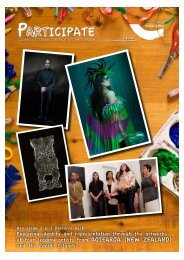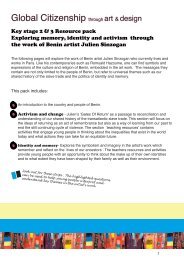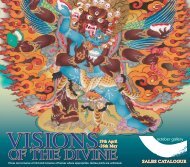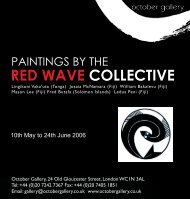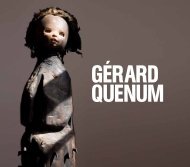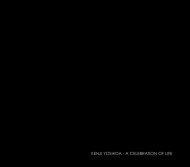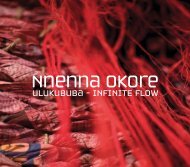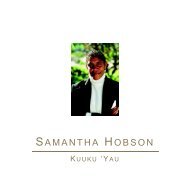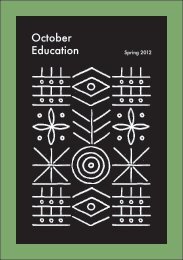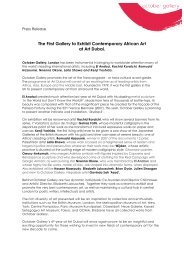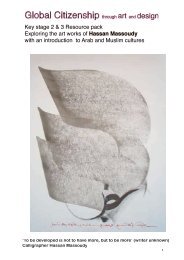View a preview of this book (PDF) - October Gallery
View a preview of this book (PDF) - October Gallery
View a preview of this book (PDF) - October Gallery
You also want an ePaper? Increase the reach of your titles
YUMPU automatically turns print PDFs into web optimized ePapers that Google loves.
AUBREY<br />
WILLIAMS<br />
Edited by Reyahn King
Published by National Museums Liverpool and<br />
<strong>October</strong> <strong>Gallery</strong>, London<br />
This catalogue accompanies the exhibitions<br />
Aubrey Williams: Atlantic Fire<br />
Walker Art <strong>Gallery</strong> 15 January – 11 April 2010<br />
and<br />
Aubrey Williams: Now and Coming Time<br />
<strong>October</strong> <strong>Gallery</strong> 4 February – 3 April 2010<br />
Walker Art <strong>Gallery</strong><br />
William Brown Street<br />
Liverpool<br />
L3 8EL<br />
www.liverpoolmuseums.org.uk<br />
<strong>October</strong> <strong>Gallery</strong><br />
24 Old Gloucester Street<br />
Bloomsbury<br />
London<br />
WC1N 3AL<br />
www.octobergallery.co.uk<br />
CONTENTS<br />
4 PREFACE<br />
Chili Hawes and David Fleming<br />
6 FOREWORD<br />
Reyahn King<br />
10 EXCERPTS FROM ‘CONVERSATION WITH AUBREY WILLIAMS’<br />
Rasheed Araeen<br />
34 AUBREY WILLIAMS: THE MAKING OF A BRITISH ARTIST<br />
Mel Gooding<br />
Edited by Reyahn King<br />
Co-edited by Chili Hawes, Maridowa Williams<br />
and Gerard Houghton<br />
Designed by Jonathan Greet<br />
Printed by Printfine Ltd., Liverpool<br />
Photography by Jonathan Greet, Andy Keate<br />
and Aubrey Williams<br />
Texts © National Museums Liverpool<br />
<strong>October</strong> <strong>Gallery</strong> and authors<br />
Images © Estate <strong>of</strong> Aubrey Williams<br />
All rights reserved, DACS 2009<br />
Front cover:<br />
Hymn to the Sun IV, 1984 (Olmec Maya series)<br />
46<br />
56<br />
60<br />
64<br />
AUBREY WILLIAMS: ATLANTIC FIRE<br />
Leon Wainwright<br />
LIST OF EXHIBITS<br />
EXHIBITIONS AND COLLECTIONS<br />
BIBLIOGRAPHY<br />
Catalogue in publication data available<br />
ISBN 978-1-899542-30-7<br />
All rights reserved. No part <strong>of</strong> <strong>this</strong> publication may be<br />
reproduced, stored in a retrieval system, or transmitted in any<br />
form or by any means, electronic, mechanical, photocopying,<br />
recording or otherwise, without prior permission from the<br />
publisher.
PREFACE<br />
“I consider myself very fortunate to be alive and working<br />
within the last freedom left to mankind – ART.”<br />
Aubrey Williams came with Atlantic Fire and shed light onto<br />
Now and Coming Time. Highly intelligent and well-read,<br />
Both galleries are extremely indebted to Eve Williams,<br />
Maridowa Williams and to the Aubrey Williams Committee<br />
Aubrey Williams, 1985<br />
open to the new and hoping for like-minded discourse, he<br />
for their generous help and cooperation. We are grateful<br />
came to Europe from Guyana in the early 1950s to find an<br />
for the thoughtful and provocative essays from Mel<br />
art world concerned mainly with itself and convinced that<br />
Gooding and Leon Wainwright in <strong>this</strong> catalogue, and<br />
no avant-garde existed beyond its cultural borders. Williams<br />
delighted to reprint excerpts from the stimulating interview<br />
helped pave the way for the very recent willingness to<br />
between Rasheed Araeen and Aubrey Williams, first<br />
view art without preconceived bias, without attachment<br />
published in Third Text in 1987. Our thanks are also due to<br />
to any cultural region or nation state. No matter what his<br />
Lynne Truss and Chris Wilson for lending work for the Walker<br />
subject: the demise <strong>of</strong> native Mesoamerican civilisations<br />
Art <strong>Gallery</strong> exhibition and to all those at National Museums<br />
through ecological destruction, the visual expression <strong>of</strong><br />
Liverpool and <strong>October</strong> <strong>Gallery</strong> who have contributed<br />
Shostakovich’s music, the painterly exploration <strong>of</strong> our<br />
their time and expertise to making the exhibitions and <strong>this</strong><br />
cosmos, or the essential character <strong>of</strong> birds, Williams helped<br />
catalogue possible. Our special thanks are dedicated to<br />
change what he referred to as the ‘real seeing <strong>of</strong> the<br />
the curators <strong>of</strong> these twin exhibitions: Reyahn King, Director<br />
world’.<br />
<strong>of</strong> Art Galleries, National Museums Liverpool and Elisabeth<br />
Lalouschek, Artistic Director, <strong>October</strong> <strong>Gallery</strong>.<br />
<strong>October</strong> <strong>Gallery</strong> opened in Bloomsbury, in 1979, to exhibit<br />
the Transvangarde, the cross-cultural avant-garde, and<br />
has represented Aubrey Williams since his first solo show<br />
at the <strong>Gallery</strong> in 1984, Olmec Maya and Now. The <strong>Gallery</strong><br />
has provided a platform for the emergence <strong>of</strong> some <strong>of</strong> the<br />
most innovative and exciting artists <strong>of</strong> our time. The Walker<br />
Chili Hawes<br />
Director<br />
<strong>October</strong> <strong>Gallery</strong><br />
David Fleming<br />
Director<br />
National Museums Liverpool<br />
Art <strong>Gallery</strong>, Liverpool, opened just over 130 years ago,<br />
and holds one <strong>of</strong> the oustanding collections <strong>of</strong> fine and<br />
decorative art in Europe. It continues to present the best<br />
AUBREY WILLIAMS: ATLANTIC FIRE<br />
art to the general public through historic, contemporary<br />
Walker Art <strong>Gallery</strong>, Liverpool<br />
and thematic exhibitions. These two galleries have joined<br />
15 January - 11 April 2010<br />
forces to produce two linked and overlapping exhibitions<br />
<strong>of</strong> Williams’ work together with <strong>this</strong> publication, to establish<br />
AUBREY WILLIAMS: NOW AND COMING TIME<br />
new insights into one <strong>of</strong> the twentieth century’s great<br />
<strong>October</strong> <strong>Gallery</strong>, London<br />
artistic spirits.<br />
4 February - 3 April 2010<br />
(1) Dawn & Evening Star, 1982 (Olmec Maya series)<br />
Oil on canvas, 132 x 208 cm<br />
4 5
FOREWORD<br />
By Reyahn King<br />
Aubrey Williams is an artist whose appeal crosses<br />
boundaries. Born in Guyana, he moved to London to<br />
practise as an artist, exhibiting extensively in England<br />
and Europe from the late 1950s. From 1970 Williams spent<br />
periods working in studios in Jamaica and Florida, returning<br />
to Guyana occasionally to take active part in events such<br />
as the 1972 Carifesta festival. The significance <strong>of</strong> Williams’<br />
transatlantic life for his art was in the absorption <strong>of</strong> multiple<br />
traditions, including American Abstract Expressionism<br />
and the historical Central and South American cultures<br />
that were his driving force. The essays in <strong>this</strong> catalogue<br />
contribute to an ongoing reassessment <strong>of</strong> Williams as an<br />
important international artist.<br />
Mel Gooding’s essay explains the context <strong>of</strong> Williams’<br />
arrival and early career in London in the late 1950s and<br />
1960s and critically questions how it was that <strong>this</strong> major<br />
British post-war artist was overlooked. Gooding describes<br />
Williams’ abstraction and its modernist sources, positioning<br />
him within a British art tradition exemplified by artists like<br />
Patrick Heron and John Hoyland. Both Gooding and Leon<br />
Wainwright demonstrate that it was Williams’ very strengths<br />
<strong>of</strong> global experience and his deep knowledge expressed<br />
subtly in painting that British peers failed to understand or<br />
feel. Gooding’s essay is an effective riposte to the failures<br />
<strong>of</strong> the art world to recognise Williams in his lifetime and<br />
Wainwright takes on the later interpretations that have<br />
risked limiting the artist to a role within political cultural<br />
agendas 1 .<br />
Coming from the art world periphery, Williams absorbed<br />
traditions centred in European and American culture<br />
and enriched them. 2 His friends and colleagues in the<br />
Caribbean Artists Movement led the recognition and<br />
development <strong>of</strong> distinctive literary voices and they, like<br />
him, saw similar potential in other art forms. Decades later,<br />
Andrew Dempsey’s assessment <strong>of</strong> Williams confirmed<br />
‘that what <strong>this</strong> artist from the Caribbean had brought to<br />
painting in England had the kind <strong>of</strong> vitality with which<br />
writing in English had been injected by the poets and the<br />
novelists <strong>of</strong> the Caribbean such as Derek Walcott and V. S.<br />
Naipaul or … Edward Kamau Brathwaite.’ 3 Williams himself<br />
knew the value <strong>of</strong> his contribution to European painting<br />
but the undermining assumptions he faced are typified<br />
by a disappointing meeting with Picasso: ‘I remember the<br />
very first comment he made when we met. He said that<br />
I had a very fine African head and he would like me to<br />
pose for him. And I felt terrible. In spite <strong>of</strong> the fact that I<br />
was introduced to him as an artist, he did not think <strong>of</strong> me<br />
as another artist.’ 4<br />
Williams resisted classification <strong>of</strong> himself or his art and<br />
although he was best known as an abstract artist, he<br />
painted representational works throughout his life. In the<br />
Olmec Maya series he combined abstract technique with<br />
icons <strong>of</strong> South and Central American ancient cultures. This<br />
mixing <strong>of</strong> abstract and figurative work troubled people<br />
familiar with a particular set <strong>of</strong> artistic rules that kept them<br />
separate. Wainwright argues that these rules no longer<br />
(2) Maya Confrontation, 1982 (Olmec Maya series)<br />
Oil on canvas,120 x 178 cm<br />
6<br />
7
apply and suggests that other challenges to modernism,<br />
and art practice since Williams’ death, enable us now to<br />
see Williams as a visionary artist ahead <strong>of</strong> his time.<br />
regardless <strong>of</strong> background. Williams understood that the<br />
destruction that took place in the Americas <strong>of</strong> the past and<br />
what happens now in South American forests has global<br />
relevance. Today, when our newspapers inform us about<br />
the interconnected environmental state <strong>of</strong> our world, we<br />
may more easily appreciate Williams’ timeless vision.<br />
In 2010, over ten years since the Aubrey Williams exhibition<br />
at the Whitechapel <strong>Gallery</strong>, two solo exhibitions are being<br />
held concurrently in the North and the South <strong>of</strong> England.<br />
The <strong>October</strong> <strong>Gallery</strong>, mounting Aubrey Williams: Now and<br />
Coming Time in London, has consistently drawn attention<br />
to the importance <strong>of</strong> Williams’ work, while the exhibition<br />
Aubrey Williams: Atlantic Fire at the Walker Art <strong>Gallery</strong> in<br />
Liverpool is the first time that a solo exhibition <strong>of</strong> his work has<br />
been held in one <strong>of</strong> the UK’s national museums.<br />
There have been some longstanding individual champions<br />
<strong>of</strong> Williams’ work, notably Anne Walmsley, Guy Brett and<br />
Rasheed Araeen, whose 1987 interview remains an insightful<br />
resource. Nevertheless, full recognition is overdue. His<br />
independent and intelligent approach to modern painting,<br />
the authenticity <strong>of</strong> his concerns, and the emotional strength<br />
and impact <strong>of</strong> his work mean that Williams is an artist who<br />
can no longer be overlooked.<br />
These exhibitions acknowledge and celebrate the way<br />
that Williams used the cultural inheritance <strong>of</strong> Carib, Warrau<br />
and Arawak peoples and Maya, Olmec, Aztec, Toltec and<br />
Inca civilisations to create masterpieces <strong>of</strong> modern art.<br />
Taking inspiration from close acquaintance with the Warrau<br />
people and their living artistic culture, Williams developed<br />
a passion for the historic indigenous cultures in Central and<br />
South America in and beyond Guyana. 5 The references<br />
to these in his work are not illustrations. Titles such as<br />
Bonampak are not to be interpreted literally. Rather, these<br />
historic cultures emerge as expressions <strong>of</strong> a deeply felt and<br />
researched inheritance <strong>of</strong> an artist <strong>of</strong> subtlety and power.<br />
Williams claimed them because they enabled him to find<br />
a distinctly Caribbean artistic language: ‘I firmly feel that<br />
such art should be automatically appreciated by people<br />
from the Caribbean and from Guyana because they share<br />
the same environment.’ 6 At the same time, he considered<br />
that the Olmec and Mayan civilisations, in particular, could<br />
and should be meaningful and an inspiration for everyone,<br />
1 See also R. ARAEEN. (2006) ‘When the Naughty Children <strong>of</strong> Empire<br />
Come Home to Roost’. Third Text. Vol 20 (Issue 2) pp. 233-239.<br />
2 Authors who have made powerful arguments along these<br />
lines include Kobena Mercer (K. MERCER. (2006) ‘Black Atlantic<br />
Abstraction: Aubrey Williams and Frank Bowling’. In: K. MERCER.<br />
(2006) Discrepant Abstraction. InIVA / MIT. London / Mass. pp. 207-<br />
219) and Mel Gooding in ‘Aubrey Williams: The Making <strong>of</strong> a British<br />
Artist’ in <strong>this</strong> catalogue. pp. 38-44.<br />
3 A. DEMPSEY. (1998) ‘Curator’s Foreword’. In: WHITECHAPEL GALLERY<br />
in association with InIVA Institute <strong>of</strong> International Visual Arts. Aubrey<br />
Williams. [exhibition catalogue 12 June – 16 August] InIVA<br />
Institute <strong>of</strong> International Visual Arts. London. p. 12.<br />
4 R. ARAEEN. Excerpts from ‘Conversation with Aubrey<br />
Williams’. Reprinted in <strong>this</strong> catalogue. pp. 17-18. Originally published<br />
in Third Text. (2) pp. 25-52.<br />
5 Williams frequently used the term pre-Columbian to describe the<br />
group <strong>of</strong> cultures that inspired him and it is still one <strong>of</strong> the clearest<br />
ways <strong>of</strong> referring to cultures prior to European contact. However,<br />
some people today object to Central and South American history<br />
being defined by the arrival <strong>of</strong> Columbus. Specialists now tend to use<br />
Mesoamerican but <strong>this</strong> is not a well known term and defines a clear<br />
geographic area that does not match Williams’ breadth <strong>of</strong><br />
knowledge. The term Amerindian is also widely used but not<br />
considered appropriate by others who prefer indigenous or Native.<br />
There is ongoing debate around correct terminology in <strong>this</strong> area and<br />
throughout <strong>this</strong> publication authors have used the terminology they<br />
carefully consider most appropriate. Where possible, specific terms to<br />
describe the culture referred to are used in <strong>this</strong> publication. However,<br />
Williams’ interest covered several peoples and civilisations and it is<br />
neither possible, nor helpful to the meaning <strong>of</strong> his art, to attempt to<br />
define which specifically is referenced.<br />
6 A. WILLIAMS. (1967) ‘The Predicament <strong>of</strong> the Artist in the Caribbean’.<br />
Talk given at CAM Conference, Canterbury, 16 September 1967.<br />
Reprinted in A. WALMSLEY. (1990) Guyana Dreaming: The Art <strong>of</strong><br />
Aubrey Williams. Dangaroo Press. Aarhus, Denmark. p. 19.<br />
left: (3) Hymn to the Sun IV, 1984<br />
(Olmec Maya series)<br />
Oil on canvas, 119 x 178 cm<br />
right: (4) Symphony, 1985<br />
Oil on canvas, 125 x 183 cm<br />
8 9



